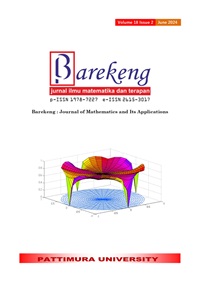ON THE MOMENTS OF THE 3-PARAMETER GOMPERTZ DISTRIBUTION
Abstract
Gompertz distribution is a classical probability distribution extensively used in actuarial science, reliability, and survival analysis. Gompertz distribution also plays a role in various fields, such as biology, economics, and marketing analysis. Some extensions of this distribution have been studied and applied to various problems. In this article, we are concerned with some statistical properties of a 3-parameter Gompertz distribution. This extension of the Gompertz distribution introduced has been used in studying competing risk survival analysis. Our main results are the derivation of moments of this distribution and other statistical properties related to moments, such as moment generating function, mean residual life function, mean inactivity time and Lorenz curve. These results will serve as a complement to the theoretical aspect of the analysis of the distribution.
Downloads
References
I. Olkin and A. W. Marshall, Springer Series in Statistics Life Distributions Structure of Nonparametric, Semiparametric, and Parametric Families, 1st ed. 2007.
A. C. Bemmaor and N. Glady, “Modeling purchasing behavior with sudden ‘death’: A flexible customer lifetime model,” Manage Sci, vol. 58, no. 5, pp. 1012–1021, May 2012, doi: 10.1287/mnsc.1110.1461.
K. Ohishi, H. Okamura, and T. Dohi, “Gompertz software reliability model: Estimation algorithm and empirical validation,” Journal of Systems and Software, vol. 82, no. 3, pp. 535–543, Mar. 2009, doi: 10.1016/J.JSS.2008.11.840.
A. C. Economos, “Rate of aging, rate of dying and the mechanism of mortality,” Arch Gerontol Geriatr, vol. 1, no. 1, pp. 3–27, May 1982, doi: 10.1016/0167-4943(82)90003-6.
A. Lenart and J. W. Vaupel, “The Gompertz distribution and Maximum Likelihood Estimation of its parameters - a revision,” 2012. [Online]. Available: http://www.demogr.mpg.de
S. Dey, F. A. Moala, and D. Kumar, “Statistical properties and different methods of estimation of Gompertz distribution with application,” Journal of Statistics and Management Systems, vol. 21, no. 5, pp. 839–876, Sep. 2018, doi: 10.1080/09720510.2018.1450197.
T. G. Ieren, F. M. Kromtit, B. Uke Agbor, I. B. Eraikhuemen, and P. O. Koleoso, “A Power Gompertz Distribution: Model, Properties and Application to Bladder Cancer Data,” Asian Research Journal of Mathematics, pp. 1–14, Oct. 2019, doi: 10.9734/arjom/2019/v15i230146.
O. D. Adubisi, C. E. Adubisi, and A. Abdulkadir, “Laplace transformed properties of the extended power-Gompertz model: Simulation and applications,” Sci Afr, vol. 19, Mar. 2023, doi: 10.1016/j.sciaf.2022.e01523.
P. O. Koleoso and A. U. Chukwu, “A Weibull-Gompertz Makeham Distribution with Properties and Application to Cancer Data,” Journal of Advances in Mathematics and Computer Science, pp. 1–17, Dec. 2019, doi: 10.9734/jamcs/2019/v34i530223.
M. S. Shama, S. Dey, E. Altun, and A. Z. Afify, “The Gamma–Gompertz distribution: Theory and applications,” Math Comput Simul, vol. 193, pp. 689–712, Mar. 2022, doi: 10.1016/j.matcom.2021.10.024.
I. M. Elbatal, F. Jamal, C. Chesneau, M. Elgarhy, S. Alrajhi, and I. Elbatal, “The Modified Beta Gompertz Distribution: Theory and Applications,” 2018, [Online]. Available: https://hal.science/hal-01912274v2
J. Reyes, P. L. Cortés, M. A. Rojas, and J. Arrué, “A More Flexible Reliability Model Based on the Gompertz Function and the Generalized Integro-Exponential Function,” Symmetry (Basel), vol. 14, no. 6, Jun. 2022, doi: 10.3390/sym14061207.
B. Fisher et al., “A Randomized Clinical Trial Evaluating Tamoxifen in the Treatment of Patients with Node-Negative Breast Cancer Who Have Estrogen-Receptor–Positive Tumors,” New England Journal of Medicine, vol. 320, no. 8, pp. 479–484, Feb. 1989, doi: 10.1056/NEJM198902233200802.
S. R. Haile, J. H. Jeong, X. Chen, and Y. Cheng, “A 3-parameter Gompertz distribution for survival data with competing risks, with an application to breast cancer data,” J Appl Stat, vol. 43, no. 12, pp. 2239–2253, Jan. 2016, doi: 10.1080/02664763.2015.1134450.
R. J. Butler and J. B. McDonald, “Using incomplete moments to measure inequality,” J Econom, vol. 42, no. 1, pp. 109–119, 1989, doi: 10.1016/0304-4076(89)90079-1.
R. C. Gupta and D. M. Bradley, “Representing the Mean Residual Life in Terms of the Failure Rate,” 2003. [Online]. Available: www.elsevier.com/locate/mcm
R. A. Khan, D. Bhattacharyya, and M. Mitra, “On some properties of the mean inactivity time function,” Stat Probab Lett, vol. 170, Mar. 2021, doi: 10.1016/j.spl.2020.108993.
Stuart A. Klugman, Harry H. Panjer, and Gordon E. Willmot, Loss Models: From Data to Decisions, 5th ed. Hoboken, NJ: John Wiley and Sons, Inc. [Online]. Available: www.wiley.com
S. Pundir, S. Arora, and K. Jain, “Bonferroni Curve and the related statistical inference,” Stat Probab Lett, vol. 75, no. 2, pp. 140–150, Nov. 2005, doi: 10.1016/j.spl.2005.05.024.
M. S. Milgram, “The Generalized Integro-Exponential Function,” Math Comput, vol. 44, no. 170, pp. 443–458, 1985.
T. K. Pogány, G. M. Cordeiro, M. H. Tahir, and H. M. Srivastava, “Extension of generalized integro-exponential function and its application in study of chen distribution,” Applicable Analysis and Discrete Mathematics, vol. 11, no. 2, pp. 434–450, 2017, doi: 10.2298/AADM1702434P.
H. M. Srivastava and J. Choi, “Introduction and Preliminaries,” in Zeta and q-Zeta Functions and Associated Series and Integrals, Elsevier, 2012, pp. 1–140. doi: 10.1016/b978-0-12-385218-2.00001-3.
Copyright (c) 2024 Moch Taufik Hakiki, Dimaz Wisnu Adipradana, Imam Safawi Ahmad, Lahfanda Dista Permata Putri

This work is licensed under a Creative Commons Attribution-ShareAlike 4.0 International License.
Authors who publish with this Journal agree to the following terms:
- Author retain copyright and grant the journal right of first publication with the work simultaneously licensed under a creative commons attribution license that allow others to share the work within an acknowledgement of the work’s authorship and initial publication of this journal.
- Authors are able to enter into separate, additional contractual arrangement for the non-exclusive distribution of the journal’s published version of the work (e.g. acknowledgement of its initial publication in this journal).
- Authors are permitted and encouraged to post their work online (e.g. in institutional repositories or on their websites) prior to and during the submission process, as it can lead to productive exchanges, as well as earlier and greater citation of published works.






1.gif)



